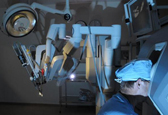
Robotic-Assisted Joint Replacement
Customized Joint Replacement using robotic-assisted technologies
With traditional joint replacement surgery, surgeons plan where to place the implant and how to align it based on images taken before surgery — but these static images don't tell them how your joint moves. That's why the orthopedic surgeons at El Camino Health use advanced robotic-assisted technology that enables them to customize the procedure, so you can enjoy a more natural-feeling joint.
Mako Robotic-Arm Assisted Joint Replacement is used for total hip replacements and both partial and total knee replacements. It offers more information by combining static images with images of your joint in motion, which are taken during surgery. Your surgeon can see how your joint moves and how your new joint will affect the ligaments and tendons surrounding it.
ROSA Knee System is used for total knee replacements. This system uses a combination of static images as well as a camera and optical trackers to allow your surgeon to see and adjust for any movement during surgery.
Robotic Control Means Greater Precision
The more information your surgeon has about the way your joint moves, the better they're able to place the new joint. Mako and ROSA technologies give your surgeon essential information and guidance to offer you a better result.
Using these advanced technologies enables your surgeon to know in advance how a particular incision will affect your joint and the surrounding tendons and ligaments. This results in fewer incisions, a faster recovery and a more natural-feeling joint.
Here's how robotic-assisted knee replacement is performed:
- A small incision is made in your knee, so your surgeon can see your knee joint.
- Robotic software is used to show how your joint moves.
- This information, along with what was learned from pre-surgical imaging scans, is used to design a customized surgical plan that allows for your joint to be precisely aligned and your ligaments to be perfectly balanced.
A Faster Recovery
Your surgeon will discuss the specifics of your recovery with you. However, most people can expect to:
- Go home the same day as surgery or the next day
- Begin walking with assistance the day of surgery and to walk with a walker up to a week afterward
- Be able to walk unassisted the second or third week after surgery
- Participate in at least six weeks of physical therapy to regain strength and flexibility around the new joint


